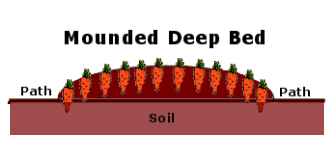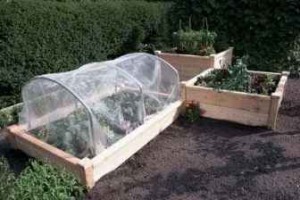Vegetable Growing in Raised Beds
In recent years the popularity of raised beds for growing for fruits and vegetables has increased but I’ve noticed many people decide to start growing this way without an understanding of the benefits and drawbacks. Lack of knowledge of the basic principles leads to poor constructions and failing to make the most of the system.
History of Raised Beds for Vegetables
Before looking at the pros and cons of deep beds, it’s worth looking a little bit into the history of modern deep bed growing.
The concept of raised bed growing goes back to medieval times where the beds would typically be edged with wattle fences. Moving forward 500 years or so, the Parisian market gardeners of the 18th Century built up their plots using the plentiful horse manure of a pre-motor vehicle city and compost. Eventually they had depths of topsoil well in excess of a metre, sometimes two metres!
However the raised bed concept as we know it today became popular in the early 1970s where the construction was to dig over a bed to a deep and fine tilth which was mounded between paths. Because the bed was a rounded shape there was more surface area to grow on and this, coupled with higher density planting increased yield. (see diagram)
The golden rule was not to walk on the bed, only the paths, which avoided compacting the soil. Once established the only digging was in the normal cultivation, weeding and harvesting of root crops.
Unfortunately heavy rain would wash the soil from the bed onto the paths and cultivation caused soil to be spread onto the paths which defeated the object of the exercise.
Converts to deep raised bed growing soon moved onto walled sides to their deep bed, losing the benefit of the additional area, which was not much but gaining the stability of walled construction.
Is Raised Bed Growing for You?
Before spending money on materials and time constructing deep beds you should really consider if they are the right thing for you. Weigh the advantages and disadvantages carefully before going into construction.
Advantages and Disadvantages of Raised Bed Growing
- Constructing deep beds correctly is hard work and can be quite costly in terms of materials but once done they are easy to maintain and should last for many years.
- Yield per square foot is higher with a deep bed but the space taken up by paths means that total yield is generally equal to ordinary growing methods.
- Because of the closer planting with deep beds weeds are suppressed but they still require weeding and this is usually done by hand, which takes longer than hoeing a conventional row.
- Psychologically deep beds are easier to keep in order as you can select and clear a bed at a time rather than coping with a whole plot.
- Not all vegetables are ideal for deep beds and for some vegetables you will probably need to select varieties that are suitable for close spacing just as for container growing.
- Deep beds can be ideal for purpose made large cloches and fleece supports.
- Raised beds generally enable you to create high quality areas of deep topsoil if your soil is poor but are a lot of effort if you have a good quality soil to start with.
- Raised beds can raise the soil level if you suffer with water logging but they will need watering in dry weather.
- Deep beds can be very attractive and enhance a garden situation where a normal vegetable plot would look out of place.
- Raised beds are, once the hard work of construction is done, easier to maintain and enable those less physically able to continue growing when they are not up to digging over large plots.
Decorative Raised Beds in a Garden

Decorative Raised Beds from Harrod Horticulture
These attractive raised beds are designed for easy assembly and have a selection of crop protection hoops etc available.
They are made from sustainable treated Swedish redwood and come in a range of sizes and options.They also offer an inexpensive standard range.
More Information Harrod Horticultural
Before I go on to constructing a raised bed, in a garden situation you can make raised beds a very attractive feature.
Instead of laying out in the most efficient manner you can make them into architectural features, altering the height of some beds to provide focal points.
Technically there is no reason to stick with rectangular or square beds – hexagonal and octagonal beds can be built so long as you can reach to the centre of the bed without having to walk on it
One idea I liked was to construct the beds utilising old scaffold boards stacked two and three high but then covered with woven willow panels (hurdles).
These were raised above the bed edge providing a sheltered micro-climate inside the beds as well as an attractive addition to a formal garden
See Part Two of this Article – How to Construct a Raised Deep Bed
Further Information on Raised Beds
- Setting Up Raised Beds
- Building a Raised Bed Using Link-a-bord
- Building the Wooden Raised Beds
- More Raised Beds




